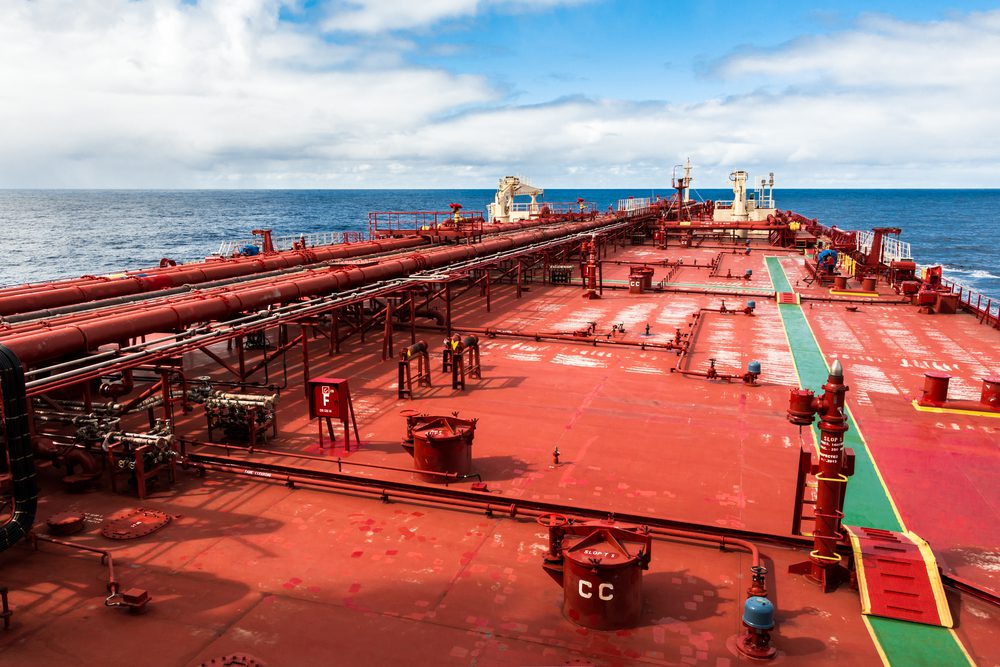Anatoly Menzhiliy / Shutterstock
 LONDON, April 23 (Reuters) – Iran has said it would block the Strait of Hormuz if it was barred from using the strategic waterway through which about a fifth of oil that is consumed globally passes.
LONDON, April 23 (Reuters) – Iran has said it would block the Strait of Hormuz if it was barred from using the strategic waterway through which about a fifth of oil that is consumed globally passes.
The threat from an Islamic Revolutionary Guards Corps (IRGC) commander followed a U.S. announcement on Monday that it would end exemptions granted last year to eight buyers of Iranian oil and demanding they stop purchases by May 1 or face sanctions.
Oil prices have surged to six-month highs.
The Strait of Hormuz, a vital shipping route linking Middle East oil producers to markets in Asia, Europe, North America and beyond, has been at the heart of regional tensions for decades.
Iran has made threats to block the waterway in the past, without acting on them.
Below is some background about the Strait:
WHAT IS THE STRAIT OF HORMUZ?
* The waterway separates Iran and Oman, linking the Gulf to the Gulf of Oman and Arabian Sea.
* The Strait is 21 miles (33 km) wide at its narrowest point, but the shipping lane is just two miles (three km) wide in either direction.
WHY DOES IT MATTER?
* The U.S. Energy Information Administration estimated that 18.5 million barrels per day (bpd) of seaborne oil passed through the waterway in 2016. That was about 30 percent of crude and other oil liquids traded by sea in 2016.
* About 17.2 million bpd of crude and condensates were estimated to have been shipped through the Strait in 2017 and about 17.4 million bpd in the first half of 2018, according to oil analytics firm Vortexa.
* With global oil consumption standing at about 100 million bpd, that means almost a fifth passes through the Strait.
* Most crude exported from Saudi Arabia, Iran, the United Arab Emirates, Kuwait and Iraq — all members of the Organization of the Petroleum Exporting Countries — is shipped through the waterway.
* It is also the route used for nearly all the liquefied natural gas (LNG) produced by the world’s biggest LNG exporter, Qatar.
* During the 1980-1988 Iran-Iraq war, the two sides sought to disrupt each other’s oil exports in what was known as the Tanker War.
* The U.S. Fifth Fleet, based in Bahrain, is tasked with protecting the commercial ships in the area.
* “While the presence of the U.S. Fifth Fleet should ensure that the critical waterway remains open, provocative Iranian military maneuvers are likely in the immediate offing as is a nuclear restart,” analysts at bank RBC said on April 22.
* Iran agreed to rein in its nuclear program in return for an easing of sanctions under a 2015 deal with the United States and five other global powers. Washington pulled out of the pact in 2018. Western powers fear Iran wants to make nuclear weapons. Tehran denies this.
* “All of these geopolitical stories could present a cruel summer scenario for President (Donald) Trump as he seeks to keep oil prices in check,” the RBC analysts said.
ARE THERE ALTERNATIVE ROUTES FOR GULF OIL?
* The UAE and Saudi Arabia have sought to find other routes to bypass the Strait, including building more oil pipelines.
* The following EIA table shows existing pipelines and proposed projects:
HAVE THERE BEEN INCIDENTS IN THE STRAIT BEFORE?
* In July 1988, the U.S. warship Vincennes shot down an Iranian airliner, killing all 290 aboard, in what Washington said was an accident after crew mistook the plane for a fighter. Tehran said it was a deliberate attack. The United States said the Vincennes was in the area to protect neutral vessels against Iranian navy attacks.
* In early 2008, the United States said Iranian boats threatened its warships after they approached three U.S. naval ships in the Strait.
* In June 2008, the then Revolutionary Guards commander-in-chief, Mohammad Ali Jafari, said Iran would impose controls on shipping in the Strait if it was attacked.
* In July 2010, Japanese oil tanker M Star was attacked in the Strait. A militant group called Abdullah Azzam Brigades, which is linked to al Qaeda, claimed responsibility.
* In January 2012, Iran threatened to block the Strait in retaliation for U.S. and European sanctions that targeted its oil revenues in an attempt to stop Tehran’s nuclear program.
* In May 2015, Iranian ships fired shots at a Singapore-flagged tanker which it said damaged an Iranian oil platform, causing the vessel to flee. It also seized a container ship in the Strait.
* In July 2018, President Hassan Rouhani hinted Iran could disrupt oil flows through the Strait in response to U.S. calls to reduce Iran’s oil exports to zero. A Revolutionary Guards commander also said Iran would block all exports through the Strait if Iranian exports were stopped.
Sources: Reuters/Refinitiv/Energy Information Administration
(Reporting by Ahmad Ghaddar Editing by Edmund Blair) (c) Copyright Thomson Reuters 2019.

 Join The Club
Join The Club











